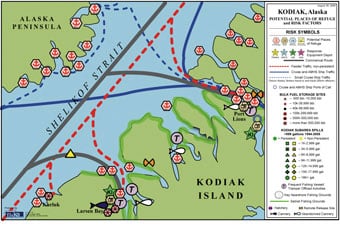
Kodiak Potential Places of Refuge
Leaking or disabled vessels may require a sheltered location with adequate water depth to repair or lighter the vessel in order to minimize the amount of spilled product. If disabled vessels are not repaired, oil or other hazardous substances it releases can impact downstream environmental resources and shoreline. Vessels should be anchored or moored in protected waters to safely undergo repairs and minimize polluting the environment.
In 2006, Cook Inlet RCAC partnered with agency, industry, and community stakeholders to develop the Kodiak Potential Places of Refuge project to identify places where a stricken vessel may best find shelter. Once identified, suitable emergency mooring locations are included in the Kodiak Subarea Contingency Plan.
Kodiak has some of the most environmentally sensitive coastal areas in Alaska. In addition to sensitive shoreline habitats such as marshes, sheltered tidal flats, and exposed tidal flats, Kodiak supports a number of sensitive biological resources including birds, fish, shellfish, and marine mammals. The area contains national refuges, national parks, state critical habitat areas, state parks, native and other private lands, and is managed for a variety of uses. Kodiak is also widely used for marine commerce and has significant traffic passing nearby en route to other ports. As international trade and development of Alaska’s natural resources increase, this traffic will likely intensify. Identifying places of refuge for vessels is corollary to such development.










